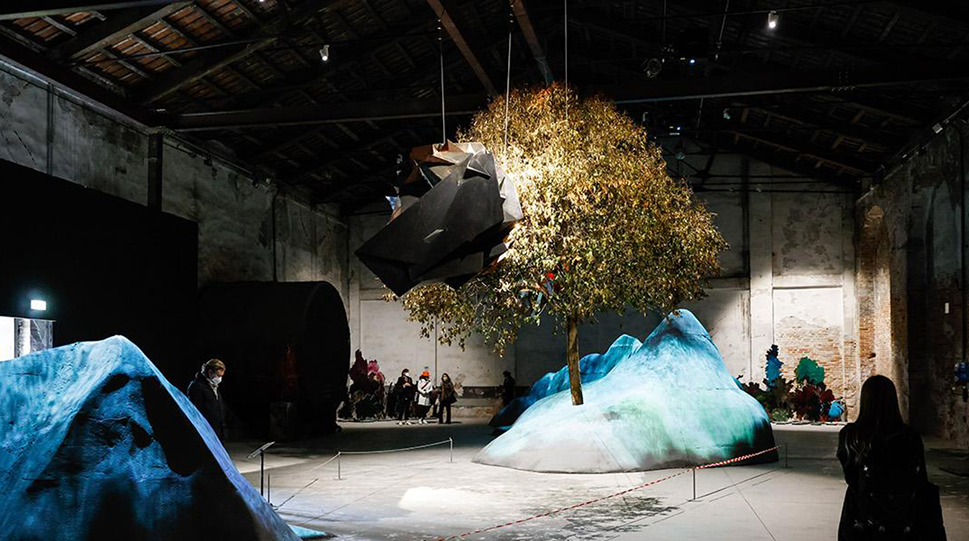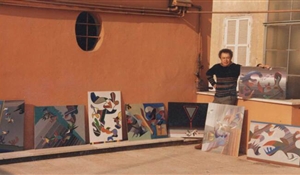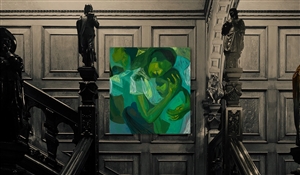The Visual Identity of the Chinese Pavilion at the 59th Venice Biennale
31 May 2022The 59th edition of the Venice Biennale has been running since April 11, 2022. This edition, named after the book "The Milk of Dreams" by Leonora Carrington, has gathered works by artists from over 80 different countries and will continue until November.
The Chinese Pavilion, titled "Meta-Scape" has introduced three individuals and one group of artists to display their artworks. The works by Liu Jiayu, Wang Yuyang, and Xu Lei are displayed next to "Jungle", an installation by AT group. These works, that have been presented in the dark cave-like Chinese Pavilion, are focused on the imaginary fluidity of space. Meta-Scape is inspired by the "Scape" which is represented by poetry in the Chinese traditional literary context. In fact, Meta-Scape connects an ecological image to the nature-technology-human conditions.
Zhang Zikang, curator of the Chinese Pavilion at Venice Biennale and the director of the Art Museum of the Central Academy of Fine Arts (CAFA), believes "Meta-Scape" to have been translated from the word Yuanjing. It was inspired by Lingjing, which means "Spiritual Territory" and was used by Qian Xuesen, the father of China's missile and space career, to describe virtual reality.
Liu Jiayu, one of the artists of the Chinese Pavilion who is focused on new media art, has presented an artwork titled "Streaming Stillness"; this is a digital work which uses machine learning technology on an input of over ten thousand Chinese ink wash paintings in order to produce a three-dimensional installation with computer software. Due to a prevalent interest among Chinese artists in creating AI-based artworks during 2018 and 2019, Liu Jiayu started working in this field and confined himself to producing 3D works. He says:
"During the eight years I spent traveling between London and Beijing, I began to feel more strongly about bringing Chinese culture into my art. Successful new media art can make a good impact that allows more people to see Chinese cultural elements."
Jiayu's enormous installation consists of a huge mountain range covered under a considerable amount of geographic information extracted from an AI program.
Jiayu believes that Chinese artists are different from Western artists in using technology in producing artworks; this is a result of poetic and narrative-oriented expressions in works by Chinese artists. Therefore, because of China's rich cultural and historical legacy, Chinese artists can use new media from a different viewpoint to create their artworks. He also mentioned that the lyrical character of his works originated from Chinese narrative patterns.

Digital Rendering of the Chinese Pavilion at the 59th Venice Biennale | Source: «www.theartling.com»
Viewers who come to visit the Chinese Pavilion in this year's Venice Biennale, encounter a sculpture which is eight meters high and is hanging from the ceiling; this is an installation titled "Quarterly" by Wang Yuyang which is situated right next to the huge mountain range. It represents a spaceship that has hit a tree.
Another installation titled "Correspondence" by Xu Lei is also presented there. It presents aesthetic elements of both Chinese and Western art. Not only his painting skills are not confined to Chinese traditional painting, but he combines Chinese and Western signs. "Correspondence" includes multiple landscapes that suggest constant changes in social patterns.
In general, artworks displayed at the Chinese Pavilion are divided into two categories. In the "Garden", which is the outdoor area, two installations are presented: "Jungle" by AT group, and "Snowman" by Wang Yuyang. In the exhibition hall, installations by Xu Lei, Liu Jiayu, and Wang Yuyang are displayed which collectively makes the Yuanjing narrative. Dividing the word "Yuanjing" into its consisting parts can help understanding it: Yuan is another word for Meta and refers to the belief in infinity in Chinese philosophy; Jing means the "realm of mind" which refers to a space which fluidity and constant change are its features.
In an overall look, artworks exhibited in the Chinese Pavilion present a technology-oriented outlook. According to Zhang Zikang, curator of the Chinese Pavilion, a national pavilion in the Venice Biennale should present the most advanced artistic achievements that are acquired over the past two years in a country.
Source:
- www.globaltimes.cn/page/202205/1265276.shtml
- www.labiennale.org/en/art/2022/china-peoples-republic
- www.min.news/en/arts/475e15b0903a3606f6afff2b70a0f4cc.html
- www.scmp.com/lifestyle/arts-culture/article/3176365/venice-biennale-2022-7-most-interesting-highlights-asian






